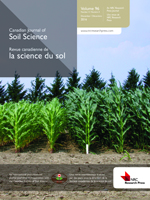Sheibani, S., Yanni, S. F., Wilhelm, R., Whalen, J. K., Whyte, L. G., Greer, C. W. and Madramootoo, C. A. 2013. Soil bacteria and archaea found in long-term corn (Zea maysL.) agroecosystems in Quebec, Canada. Can. J. Soil Sci. 93: 45-57. The soil microbial community controls all biological processes in soils and is considered a good indicator of general soil health. Assessment of the microbial community in intensively cropped soils that are under reduced tillage management is especially important because the microbes are the primary decomposers of the high residue input in such systems. We investigated the microbial biomass and diversity of bacteria and archaea in a sandy-loam Dystric Gleysol from a long-term (15 yr) corn (Zea mays L.) agroecosystem in Quebec, Canada, under conventional (CT), reduced tillage (RT), and no tillage (NT) and two residue inputs (high level: R and low level: -R). Analysis included microbial biomass C and N (MBC, MBN), catalyzed reporter deposition-fluorescence in situ hybridization (CARD-FISH) and 5-(4, 6-dichlorotriazinyl) amino fluorescein hydrochloride (DTAF) cell counts, 16S rRNA polymerase chain reaction-denaturing gradient gel electrophoresis (PCR-DGGE) and an archaeal clone library. The PCR-DGGE analysis identified Proteobacteria, Actinobacteria and Firmicutes as dominant groups in all tillage and residue management treatments. The archaeal group was diverse, with most individuals identified as belonging to the Crenarchaeota phylum. We also detected soil archaea belonging to the newly proposed phylum Thaumarchaeota, the chemolithoautotrophic ammonia-oxidizing archaeota, in a corn agroecosystem in Quebec, Canada. Microbial biomass increased in the R treatment according to MBC concentration and direct cell counts. Considering results from the CARD-FISH counts (bacterial and archaeal cell counts without fungal cells) and from MBC results (all microbial biomass including fungi) we concluded the likelihood of greater fungal biomass in the NT plots.
How to translate text using browser tools
1 February 2013
Soil bacteria and archaea found in long-term corn (Zea mays L.) agroecosystems in Quebec, Canada
Sara Sheibani,
Sandra F. Yanni,
Roland Wilhelm,
Joann K. Whalen,
Lyle G. Whyte,
Charles W. Greer,
Chandra A. Madramootoo
ACCESS THE FULL ARTICLE
It is not available for individual sale.
This article is only available to subscribers.
It is not available for individual sale.
It is not available for individual sale.

Canadian Journal of Soil Science
Vol. 93 • No. 1
March 2013
Vol. 93 • No. 1
March 2013
Archaeal phylogeny
biomasse microbienne du sol
conservation tillage
corn agroecosystem
écosystème agricole associé au maïs
gestion des résidus
Phylogénie des archaebactéries




